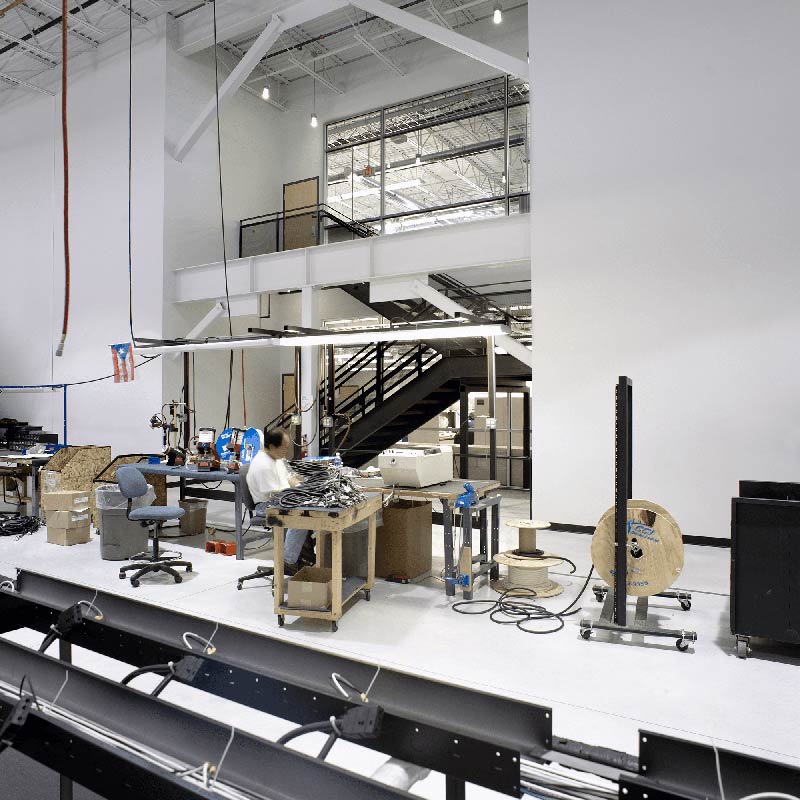While 2020 buffeted manufacturing and warehousing, these operations have more than proven their mettle, staring down one unforeseen obstacle after another. Entire enterprises have retrenched, rethought, and redeployed resources in an effort to anticipate, then address each new challenge.
Entering the third quarter of 2021, manufacturers continue to reinvent themselves, hurdling over obstacles while seizing opportunities. However, uncertainties remain. Predictive analytical models have blown up, supply chain reliability has all but disappeared, and markets shift almost daily. So, where do we go from here?
Listen to Rick Gilbertsen, VP and Senior Project Director share his insights on the manufacturing industry and discuss designing for discrete manufacturing.
THE SOON-TO-BE-COMMON DENOMINATOR
As we discuss future needs with our manufacturing clients and Strang colleagues, several recurring themes surface throughout the conversations. For example, employee safety remains an essential priority. Not that long ago, that conversation would have been limited to avoiding “industrial accidents or occupational injuries.” Not anymore. Because of global health concerns, this is now a more far-reaching, holistic topic.
Our clients seek to achieve healthier environmental conditions across their facilities’ safety spectrum. This is accomplished through integrated manufacturing facility designs coupled with agile, cross-functional floorplans. Designs must provide suitable separation of people and material flow, proper isolation and handling of hazardous materials, and adequate clearances. Clients call on designers to serve as guides through the labyrinth of ever-evolving building, health and safety regulations that address “compliance and beyond.”
DESIGN AND DATA ARCHITECTURE
Another high priority discussed within our manufacturing circles is connectivity that supports actualizing digital transformations, i.e., IoT (The Internet of Things). This includes predictive analytics and maintenance along with advanced Enterprise Resource Planning (ERP). Before too long, it has become abundantly clear that your manufacturing facilities must not only “accommodate” technologies but strengthen interdependent operational systems. In other words, your building’s design architecture must empower data architecture and the subsequent, scalable operations.
Also, your building’s design, internal engineered systems, and programmable controls need to be in sync with your current needs plus easily adaptable with ever-advancing processes. When designing your facility, it’s important to consider the process and functional requirements needed to manufacture the product. In addition, it is essential to plan for your future growth/expansion or the introduction of new products.
PATHWAYS TOWARDS AGILITY
Manufacturing project timelines are often extremely compressed – market entry, timing for a new product, or new contractual commitments oftentimes mandates an aggressive schedule. Process engineering is oftentimes running simultaneously with the building’s design. This means that any changes in your manufacturing process (discrete or repetitive) will impact the building’s design.
At Strang, we “design in” manufacturing agility from the start, in order to meet these needs. Budgeting more systems engineers’ time earlier in the design phase allows more time during early conceptualization to “right-size” flexibility and expandability across all building systems, not just the physical built environment. The key message here is accuracy first, then momentum. That’s the pathway to real, tangible agility and value.
On the warehousing front, there are countless operational variables to identify and codify. For example, Integrated Warehouse Management (IWM) remains all the buzz. There are dozens of software providers who bring warehousing automation, inventory control, and logistical direction to operations. With the continued growth of e-commerce and the advent of digitized distribution, it’s important to understand clearly how IWM will impact your manufacturing organization.
MOVING FORWARD WITH CONFIDENCE
In the previous issue of this publication, we talked about “The Energy of Change”. To sum it up, “Today, you don’t brace for change, you race towards change.” It comes as no surprise then that many of the advanced manufacturers who have grown in the past two years espouse a similar mindset. Our thoughts for the future:
- Be open to identifying and understanding how our differences can make us all stronger and ultimately more competitive. There exists a mindset of strictly differentiating between discrete, process, or even additive manufacturing. However, be willing to learn from one and the other. These sectors of precision manufacturing have more things in common than you might imagine.
- Change happens. Consider how your manufacturing operations have transformed in the last five years. Can you even imagine the changes five years forward? If your buildings can embrace change and be prepared to capitalize on industry transformations, the benefits will be considerable. Shop floor changeovers need not be expensive, problematic, or time-consuming. So, no matter if you’re involved in manufacturing, warehousing, or (very likely) both, get comfortable with being uncomfortable, because change can be unnerving, or it can be exhilarating.
- Keep a perspective on the horizon. Markets change. Customer priorities and spending patterns shift. Your product lines will naturally evolve and advance, thus your factory floor capacities and processes will need to be adjusted. This applies to discrete, process, and additive manufacturing. There’s a reasonably good chance you’re currently set up – or will be – to handle all three, to some degree, simultaneously. A discrete manufacturer today can also be a process manufacturer tomorrow. Keep vertical integration and market expansion at the top of mind.
In summary, regardless of how robust your Cloud platform is, how advanced your manufacturing processes are, or how smart your scalable systems have become, if your buildings don’t work for you, they’re working against you.
If you would like to discuss your manufacturing facility potential, reach out to Rick Gilbertson, VP and Senior Project Director on some of Strang’s largest and most advanced manufacturing facility projects.











